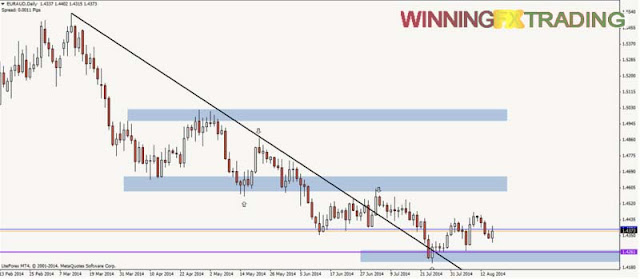If it is going to be a trader, you will lose money at some point, and if still in the phase of trying to avoid all missed transactions and look for a
trading system for the " Holy Grail " with a strike rate of 75 %, you must forget all that now. No matter how cliché it sounds, really losing is part of winning as a trader ; The two are inseparable. If you learn to not lose properly, you will never make money as a
trader consistently.
Reality check ... All professional traders lose money and understand that is only part of the "game". Unfortunately, for many traders, each trade is accompanied by a tremendous fear of losing money and sometimes an intense emotional attachment.
Some of the key reasons why traders fear losing their money include:
1. They do not understand that, mathematically, in a series of exchanges, a trader can lose most of their exchanges and still be widely profitable, simple mathematics prove it.
2. Simply fear losing money overall.
3. They are trading positions that are too large (more risk than they should actually be), causing fear, sleepless nights and enormous emotional changes.
In the rest of this lesson, I will give you an idea of the fear of losing money in the markets and how to conquer it. These are some pretty powerful things, so make sure you read the entire article and read it again if necessary. What you learn here will empower you to eliminate your fear of losing money in the markets and help you become a confident and emotional trader.
Fear of losing money can be a good and natural emotion, but we need to transform their approach.
The fear of losing money is a good emotion in many areas of life, if we had not, there would be even more chaos in the world and markets. Humans are protective of their wealth and property acquired, and rightly so ; They worked hard for it
However, in trade, this natural to be defensive and emotional with money and refocus energy must be transformed into a different state of mind ...
Instead of being afraid of losing their money to negotiate, adopt the control you have over each operation; a trader has complete control over the risk management of each operation by stops loss and dimensioning position, [and more advanced, derivatives and hedging mechanisms (not discussed here) operators]. These tools of risk management are the way you control your money / funds and, instead of being afraid of losing money, should feel empowered and confident because it can predetermine how comfortable with the possibility of losing before entering trade by using these tools.
However, the mere use of these tools to manage your risk per trade is not enough to completely eliminate the fear of losing.
Do yourself some serious questions.
If you feel fear or any emotion when you do an exchange, you must "give a slap" in the face and make 3 big questions (and answer honestly):
1. Actually I have the knowledge and confidence to trade with real money first?
If you are exchanging your hard earned money in the markets, but do not know what your trading edge and does not have 100% confidence in their ability to analyze markets and market ... probably should not be operating. One of the most important reasons why traders fear losing their money is because they do not trust their own ability to trade! I know it seems silly, but it is very true; many traders simply have dominated trading strategy, do not have a trading journal, etc ... business plan simply are not prepared to risk real money in the markets still ... therefore they feel fear when negotiating.
2. Am I changing position size is too big for my personal profile / risk tolerance to risk per trade?
If you do not know your risk tolerance per-trade, then you first need to solve it. Basically, it's just the dollar amount you feel like you are 100% comfortable with the possibility of losing any operation; Because you can lose in any trade ... remember that. You should consider your overall financial situation and then determine how much money should jeopardize realistically and honestly on the market in any operation ... be honest with yourself here. You have to think of yourself as a risk manager and as someone who is administering funds, instead of being a petty man trying to get lucky; commercial mindset will directly influence their business results.
3. Do we really understand math behind the trading?
When I say "math behind the trade", I refer mainly to reward risk and how it relates to their percentage of overall profits. For example, in a series of 20 operations, it is likely to lose at least between 35 and 45% of the operations, and most operators who succeed lose between 40 and 50% of the time, some even 60% of the operations. hour. But through the power of reward for risk, you can lose more than you earn and still come out very profitable. We will expand this below.
Embracing the belief that losing is okay
Losing is good if you are rapidly reducing their losses and understands that doing so is simply preserving capital and their winning trades will pay for their losing trades with profits remaining. This is the power of your reward ratio of average risk in a series of operations that come into play; We will see this in action below ...
Even very profitable traders often lose more than you win, to prove this point, let's look at a case study showing 14 operations with a profit rate of only 43%. To be clear, that means losing 57% of the time and gaining only 43% of the time. It can be difficult to associate "lose" most of its operations to make money, but as I mentioned in one of my recent articles, do not have to be right to make money .
This image shows that operators can lose more profitable operations they earn and still be very profitable in a series of operations. Therefore, losing money on every trade should not worry:
Trust your trust strategy and mathematics.
As we can see in the previous hypothetical history, the mathematical calculations show us that even while we lose 57% of our operations, if we allow our winners to run from 2 to 1 or more and reduce our losses to -1R or less, the profits are they will take care of themselves It is worth noting that we include a pair of 1.5R winners, because sometimes it will make more sense to get a reward of less than 2R, depending on market conditions. The average risk reward in this example was 1: 1.75, and if you can expect an average risk reward of around 1: 1.5 or 1: 2, in the long term you should get ahead. The "secret" is to keep ALL of your losers in 1R or less and ONLY to operate when our price action advantage is really present.
If you follow a real plan, losing is easier to accept, because at least had a plan and a roadmap on what I was trying to do; the brain sees it as more logical and, therefore, is less likely to experience fear or apprehension. The concept of set and forget I always talk will help train your brain to accept losses. Also it avoids interfering with many of its operations that can cause unnecessary losses.
The "test sleepless night"
Everything we said above is necessary and important, but it really is a simple "proof of fear" that I found very effective for most traders. That test is simply to evaluate how you feel at night before going to bed while you have an exchange. If you find you can not stop thinking about her (s) exchange (s) or is glued to the screen of your computer while you should be sleeping, still afraid of losing. So here is a very simple test for you:
a simple rule ... if you can not sleep at night, comfortable and convenient with the exchanges that have in ...
1) or you are too exchanging a position size / risking too your stop level
2) Or, you have no idea what you're doing and you lack confidence in your operations
Conclusion:
Fears are historiasEl fear of losing money or losing trade can paralyze a trader, which makes high probability trade setups are lost, they question themselves constantly and can even cause can not sleep. Clearly, if we are to succeed in trading, we must overcome this fear. Conquering the fear of losing money and operations begins with acceptance; First we must accept that we will lose money and we have lost operations, even if we try to avoid them. Therefore, it makes no sense "try" to avoid losing operations, instead, we must learn to roll with them and hold them. We do this by following the concepts we discussed earlier, so resumámoslos briefly:
• Dominate our strategy of stock trading price and "trust" in it: master it, owned and believe in it.
• Manage your money and use sound risk management; this means reducing losses 1R or less and point to a risk reward decent about 1: 2 in each operation. We must also try and let some winners run for higher rewards risk as 1: 3, 1: 4 or more.
• Trust mathematics: the above example and remember that even a win rate of 40% can generate very good money with an average reward rate risk of about 1: 1.5 or more.



































